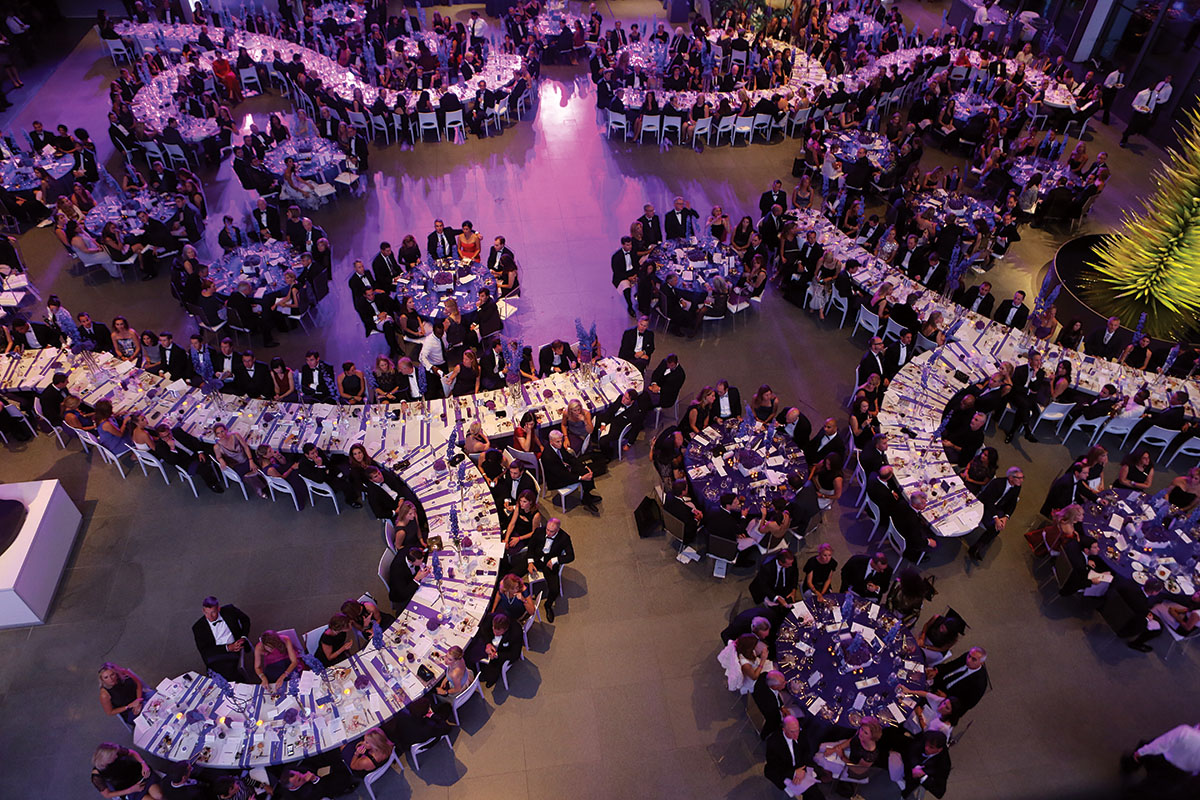The Biggest Ball of Them All

Illustration by Matthieu Forichon
Certainly there are other balls in Boston. You could wriggle into a Chanel strapless and grimace through the pain from your 5-inch Louboutins over at the Esplanade Association’s Moondance Gala on Fiedler Field, or the Friends of the Public Garden’s Green and White Ball at the Taj. But really, if your goal is to get inebriated among the divinely wealthy and dodge for “cash” in a wind tunnel while desperately trying to keep your dress below your knees, there’s only one party for you: the Storybook Ball. And if you don’t have your ticket yet for the October 18 affair ($5,000 per couple, minimum) at the Castle at the Park Plaza, then you’re clearly not among Boston’s power elite. That means you’ll miss out on this year’s candy-infused, Willy Wonka–themed event, slated to highlight many causes, like childhood obesity.
Storybook was founded 15 years ago to support the MassGeneral Hospital for Children (MGHfC). It’s an important mission: As a whole, medical care of children is chronically underfunded, and much of the work MGHfC does is not reimbursed. The hospital’s Child Protection Program, for example, which provides services for abused and neglected children, does not charge for its services, yet requires trained specialists to be on call 24 hours a day. Grants and corporate sponsorships don’t cover these costs, and money from the National Institutes of Health—which had its funding stripped in tandem with George W. Bush’s tax cuts for the very rich—has slowed.
Overshadowed in the public eye by Children’s Hospital, the MGHfC struggled in the years before Storybook. “We had no real organized way to systematically go about raising funds each year,” says MGHfC physician in chief Ronald Kleinman. So to cultivate a wealthy donor base and showcase the MGHfC’s programs, the hospital’s development office decided to hold an event. Organized by Beacon Hill philanthropists, parents of children treated at MGHfC, and Bryan Rafanelli, of Rafanelli Events, the first Storybook Ball took place at the Ritz-Carlton, now the Taj Hotel, in 2000. Its theme: “The Trumpet of the Swan,” inspired by E. B. White’s children’s book of the same name. Since then, Storybook has raised more than $20 million for the hospital. There’s no question that this is a very good thing.
But in a city where charitable giving determines social standing, philanthropy has always been a gateway to power. And at this particular moment, as Boston swells with the newly rich once again, landing on the Storybook committee is like getting an engraved invitation that reads, “You have arrived.” Meanwhile, established Yankee donors are moving on, and their offspring have little interest in gowns and balls (isn’t that what Kickstarter and ice-bucket challenges are for?). Simply put, the old-money biddies have stowed away their St. John suits in the closets of their Beacon Hill townhouses, explains one scene insider, leaving the job of raising money to a different breed of committee seeker: Boston’s attention-hungry newcomer.
Getting on the Storybook committee is now considered such a coup among the city’s lunching ladies that they’ve even been known to enlist professional help to get in. “I’ve seen people hire publicists in town that will get them invited to other events,” says one guest, “to kind of establish a presence to try to get involved. To establish an image, so to speak.” That’s why, from a healthy distance, landing one of those plum spots looks like getting knighted by a pack of vicious French poodles: “You walk in this room and it’s definitely all of the Boston socialites, that’s who it is,” says a former Storybook committee member. “And their friends…I remember sitting in some of the committee meetings and feeling like I was more concerned with my outfit and what I said than fully being present and listening to whatever the presentation was about the charity. And that’s a shame.”
The competitive nature of Boston’s philanthropic scene can lead to bad behavior. One Storybook rumor includes the banishment of a committee member because she insisted that the event hire a certain photographer—one who considered her his muse and had strong connections to magazines. “I do remember being like, Wow? Really? Someone demanded that they have their own photographer so she could get in a magazine?” says a former committee member.
Another scene insider explains the conniving behavior this way: “The kinds of women that are so desperate to validate their presence in the sphere of influence through the checks that they’re writing are also the ones that are the most insecure about their presence in that sphere, and are the most likely to retaliate if even a passing comment is said in a disparaging manner. Those are the first women to get the claws out. The ones whose positions are firmly established would never meddle in such pettiness.”
Perhaps this posturing belies a certain truth, says one former committee member: Much that glitters at Storybook comes from “the giant financial companies, the VCs, people that can obviously write it off in multiple ways. I think it’s hard for the average person to stomach that.” Of course, many of those involved in the event’s planning are truly elite philanthropists who pour their hearts into causes; others, however, just want to be elite.
And yet the institutions that rely on such generosity to sustain their livelihood are willing to put up with a touch of crazy when the threat of financial trouble is always just a few million dollars away. “The economy is horrible, and people need to survive,” says one staple of the social scene. “[Charities] are casting wider nets. They have to because they need the money.”
It’s not about the ball, insist Storybook mavens; it’s about the children. But half a year before party time, some invitees have already picked out their attire. Others consult with professional stylists who attend the spring fashion shows expressly to scout for their clients. Of course, if you buy off the rack, you’re courting disaster. One year, two women showed up in the same dress, resulting in a “Who wore it best?” competition. Some attendees have a driver wait outside the event venue to fetch a backup dress in the case of such an emergency.
To avoid the problem completely, several guests mince in custom gowns from designer Michael De Paulo, a uniquely Boston invention. The Northeastern architecture student turned eveningwear designer has endorsed a few conveniently connected women as his muses, including Tonya Chen Mezrich, wife of bestselling author Ben Mezrich, and Linda Pizzuti Henry, her good friend. They wear his one-of-a-kind, if slightly unwieldy, constructions with great confidence, and are often photographed on the designer’s arm, his skin aglow a questionable shade of orange.
At the 2011 ball, when the Park Plaza Castle was transformed into Wayne Manor for the evening’s “Batman” theme, for example, Pizzuti wore a De Paulo. Another attendee commissioned De Paulo to craft a dress featuring a $3,500, trumpet-style lace bat bustier with a blue-black lace hemline. De Paulo’s custom creations can run up to $20,000.

The 2013 ball was based on the children’s book Harold and the Purple Crayon. Photograph courtesy of mghfc
Right before the ball, committee members get to sample bling from Dorfman Jewelers, one of the event’s biggest sponsors. Dressed in cocktail attire and swilling champagne, the women “shop” for borrowed jewels to wear during the ball. It can get intense: “There is an alarm system with them, and a specific key,” says one insider, “and they open up and these women look at them and try them on, and they’re like, ‘Oh, not big enough.’”
“Most of the women seemed pretty miserable,” says an insider of the Dorfman feeding frenzy. “It was apparent at the event in that separated environment how much competition there is between the women, because they’d try something on in friend groups or frenemy groups, and then someone would be like, ‘I want to see something like that’ and gesture to something bigger.”
Lacking authentic celebrities (Tom and Gisele aside), every year the Storybook Ball social order tends to skew heavily sports. The entrance of John Henry and Linda Pizzuti Henry will cause heads to swivel, as will the arrival of Celtics CEO Wyc Grousbeck and his wife, Corinne. Money conjurers like Wellington Management president and CEO Brendan Swords and his wife, Kerry, have similar wealth—but this parity merely earns them cordial nods. The auction’s biggest spenders are typically seated up front, such as billionaire auto king Herb Chambers and pencil pusher Tom Stemberg, cofounder of Staples. And for every team owner or mogul, there are 50 wives of professional athletes swirling about, hoping to score a spot on next year’s Storybook committee.
At the center is Alli Achtmeyer. She and husband Bill Achtmeyer—formerly of Bain & Company, now chairman of the Parthenon Group—are among the biggest donors to Boston’s cultural institutions, including the MFA and the Boston Symphony Orchestra. With the stature of an ice queen but the street smarts to avoid social clamoring, Alli, a California native, is both the black and the white swan of the scene. Unlike other wealthy wives, discretion is her religion. Everyone wants to be like Alli, but she’s untouchable.
The supporting cast is a select group of media personalities invited to ensure fawning press coverage. The ideal photo placement is in the party pages of Boston Common, a free-distribution glossy that stands in as a social register for the nouveau riche. On the next rung down is a mention in the Herald’s “Inside Track” column, or the Globe’s “Names” section. For a certain kind of attendee, getting into print is an obsession. It can entail heavy flirtation with popular event photographers like industry staple Michael Blanchard, or the charmingly earnest Globe shutterbug Bill Brett. Of the clamoring type, one Boston media personality says, “You can spot them from a mile away, crouching in for a selfie, and very diligently spelling out their name and enunciating each letter, lest it be misspelled in the Globe. To suffer that indignity.”
Around dawn on October 19, 2013, at the Museum of Fine Arts, producers from Rafanelli Events and production workers hired for the day are busy setting up. Day staffers are instructed not to mingle with the MGHfC people, nor socialize with Rafanelli’s staff, known to some hotel event coordinators as “The Mean Girls of Event Planning.”
Meanwhile, the ladies of the evening visit salons for updos or blowouts, entrusting their locks to only a few of Boston’s myriad salons: Jeffrey Dauksevich’s JSD Group, Salon Mario Russo, and Bradley & Diegel. Ball day is a marathon for the popular makeup artist Tavi de la Rosa, known as an eyelash guru, who hops from townhouse to townhouse on appointments. At some homes, he’s asked to take off his shoes before entering, to protect the floors. Later, he may be asked to leave via the back entrance, but he doesn’t mind. “They’re very nice back entrances,” he says.
To match the 2013 theme—inspired by the Crockett Johnson children’s classic Harold and the Purple Crayon—Boston’s elite stock their Bottega Veneta clutches with purple products specially purchased by their makeup artists for touchups throughout the evening. But it’s not just the makeup that’s purple. Everything is. Jewel-toned lighting fills the MFA. Some find the color scheme festive: “It can kind of feel like a very expensive bat mitzvah,” says an event insider. “Not that I’m Jewish,” she adds. One guest quips, “It was like Barney had barfed all over the entire thing.”
Beacon Hillers Kerry Swords and her 2013 cochair, Katherine O’Keeffe, mingle. Swords sports a De Paulo leather peplum halter top paired with a high-slit silk skirt. The Harvard Business School grad has served as a trustee at the Park School, and on the council at the Pine Street Inn. Her athletic build reveals her passion for marathons and triathlons.
O’Keeffe (wife of Ian O’Keeffe, of FOC Partners) has the wholesome, all-American look appropriate for a visit to the Kennedy compound. Her shoulder-length blond hair is swept back to her neck, and she has spiced up her makeup for the evening by wearing a slightly plum lipstick.
The tables are set for a brilliant feast but the food is slow in coming, and the barrage of alcohol on empty stomachs makes for grouchy party guests, some of whom, particularly the husbands, would prefer to be at home watching the Red Sox battle the Detroit Tigers in Game 6 of the American League Championship Series. Those keeping up on their smartphones rest easy when Shane Victorino’s grand slam ensures the Red Sox a World Series spot.
“Nobody expects this to be crystal chandeliers and embroidered tablecloths,” says Patty Ribakoff, former cochair of the committee and current trustee at the hospital. “It can be craft paper on the table, and, in fact, that might actually be better, because people know the money they’re giving is going toward what they’re fundraising for.” But of course there are chandeliers, and china set in front of every guest, though the only thing on guests’ plates at this moment is a place card that was measured with a ruler by multiple members of the Rafanelli Events staff to ensure that each was equidistant from the center of the plate, the edge of the table, and the next plate.
After dinner, the carnival begins. Guests purchase a $500 admission bracelet to play games like Skee-Ball and Whac-a-Mole and win luxury prizes, such as tickets to Patriots games, gift cards for free haircuts, and even a Goyard handbag.
At one station, a mechanical claw drops down inside a glass-enclosed box filled with gift bags of expensive cosmetics and bath products from Fresh. As the night progresses, partygoers grow frustrated with their inability to win, says one event worker, so the production staff lowers the difficulty level. “When you’re playing the games, people will say, ‘Oh, another candle, that’s $40 off the $500 I just spent on the bracelet.’ Like they’re trying to get it back,” says one attendee. “It’s fun, but keep your eye on the prize. The prize should be the charity.”
Back in 2011, the cash grab, where guests reach for handfuls of fake money while a gigantic fan blows the dollars around, drew a crowd. Female players held down their gowns, Marilyn Monroe–style, as they reached. “I remember it being hilarious seeing these women in nice dresses going for cash grabs,” one guest recalls. “That was where the class left the building. I do remember definitely seeing the ladies of Boston getting a little inebriated.”
Alcohol does seem to raise guests’ dander: “People would get so fucking competitive over these stupid games,” notes one employee. “And people were totally wasted, almost fistfighting. One woman…she did have to be very politely escorted out. You see, these very wealthy people get really ugly.”
Then there is the live auction. Before the market crashed in 2008, finding people willing to donate $100,000 to MGHfC was a much simpler task. The sum raised to benefit the hospital was as much as $2.5 million in 2005 and $2.6 million in 2007. “The auctions were always kind of wild,” says Wendy Goldstein Pierce, a former committee member who describes luxe prizes such as a private jet for you and your friends to the Chanel runway show in Paris, or a trip to wine country. But when the economy tanked, “that all stopped everywhere.” It hasn’t yet recovered. Last year’s ball raised about $1.6 million.
Forced to roll back the opulence, “the auction became more about how can you give back to the hospital rather than putting incredible auction items into the hands of people who have many of them,” Ribakoff says. Instead, items included things like a private birthday party for your child at a local boutique, which also provided a birthday party at the hospital, or the Fund-a-Fellow program, which paid for medical research hurt by NIH cuts. In 2008, 14 of the Fund-a-Fellows sold at $50,000 each.
Big auction items last year included the “Einstein and Switzerland” package: The highest bidder got a Patek Philippe watch from Dorfman Jewelers; a business-class trip to Geneva, Switzerland, for a stay at the Mandarin Oriental; and a tour of the “God Particle” Accelerator. Some of the big auction items were quietly pre-sold to heavy hitters to guarantee an exciting night of paddle-raising, multiple sources told me.
Surrounded by the whirl of lights, money, and prizes, however, it can be difficult to maintain perspective. When a pair of vintage jeweled earrings came up on the block at the 2011 ball, a gentleman in a tuxedo turned to his wife, a regal woman of around 60, and offered to bid on them for her. Some guests expected the society doyenne to perk up.
Instead, she sniffed, “I don’t want used earrings.”
Fairy Godmothers (and Fathers)
The pros who turn the privileged into princesses, for just one night. By Stephanie Simon
 Mario Russo
Mario Russo
The Coiffeur
Service: Twisting unruly locks into an updo
Cost: $85 to $125
“We pay attention to red carpet looks and that’s what we present to clients when they come in. We really bring out the big guns for [Storybook].”
 Michael De Paulo
Michael De Paulo
The Fashion Designer
Service: Guaranteeing one-of-a-kind attire
Cost: Custom gowns start at $2,500
“There is a return to clean and sophisticated glamour stripped away from flashy ornament… an emphasis on silhouette and geometric detailing.”
 Tavi de la Rosa
Tavi de la Rosa
The Eyelash Guru
Service: Facial beautification, including makeup and eyelash application
Cost: Private appointments start at $150
“An inspiring and glamorous event that merits a dazzling entrance.”
 Christina Pierce
Christina Pierce
The Personal Stylist
Service: Dressing for a dramatic entrance
Cost: Red-carpet-ready styling starts at $500
“I always look for eye-catching, celebrity-worthy designs not usually seen in Boston. We’re eyeing looks featuring color, sparkle, and playful drama.”
photographs courtesy of accelerant studios (mario russo); mike diskin (Michael De Paulo); keiko hiromi (tavi de la rosa); todd lee (christina pierce)

